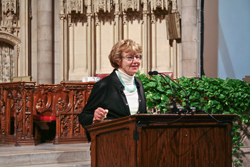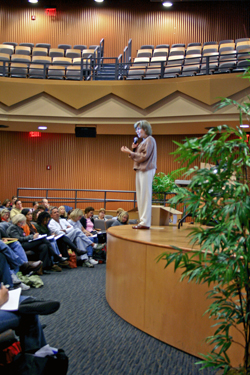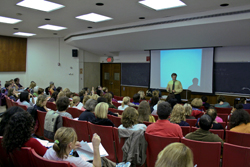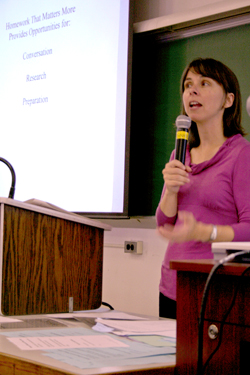Reading, Writing and Reuniting
The Teachers College Reading and Writing Project convenes its ranks of heroes
“We need to rethink the concept of the hero. The courage of a hero is not fearlessness, but instead that of someone who is determined to fight the long defeat.”
That was the message delivered by famed children’s author Katherine Paterson to some 1,800 teachers at the 77th Saturday Reunion of the Teachers College Reading and Writing Project, held on October 24. Speaking in the cavernous nave of Riverside Church, two blocks from TC, Paterson—a long-time author in her late 70s who has won a National Book Award for The Great Gilly Hopkins and a Newbery Medal for Bridge to Terabithia and Jacob Have I Loved—said that Paul Farmer, the Harvard physician and anthropologist who has fought disease in Haiti and other developing countries, is one such hero. And so, she said, are teachers.
“As imperfect as we all are, remember friends, we are making common cause with children, and we must not surrender to despair or cynicism,” Paterson
It was a fitting way to begin celebrating the Reading and Writing Project’s three-decades-old effort that has been very much about keeping hope and imagination and alive, both for teachers and young students. Created by Lucy Calkins, TC’s Robinson Professor of English Literature, as a teachers collective within a single New York City school district, the Reading and Writing Project today arguably conducts more professional development for elementary and middle school educators than any other organization in the country. It has contributed to test score gains in New York City , Chicago , Seattle
But perhaps most of all, the Reading
Workshops were hosted by an array of speakers, including Calkins herself, the author of numerous books about teaching reading and writing; Carl Anderson, whose latest book is Strategic Writing Conferences Grades 3–6; and Kathy Collins, author of books including Growing Readers.
In her late morning workshop, “The Intersection of Reading Records and Reading Instruction,” Calkins suggested that teachers cluster book levels for young readers, which range from A–Z, into “bands” that encompass different ranges of challenges and skills.
For example, books within the band encompassing reading levels N, O, P and Q have more complicated characters–often including a character who clearly undergoes a change—and use figurative language. Calkins cited the book Amber Brown is not a Crayon, by Paula Danzinger, in which the heroine of the title grapples with the loss of family and friends who move away even as her class at school imagines trips to faraway countries.
“The books we read pose different kinds of difficulties for our readers,” Calkins explained, suggesting that bands make it easier to target those difficulties.
During one of the many workshops he hosted during the reunion, Anderson Anderson Anderson
Collins began her workshop “Making Home-School Connections: Meaningful Homework in K–2 Classrooms” by arguing that there is little research showing that homework benefits students prior to middle school.
Then why offer it? Because homework in the primary grades provides a forum of communication between school and home and offers opportunities to grow what Collins termed “positive habits of mind.”
“We can frame our homework to frame kids learning dispositions,” she said, adding that homework should provide opportunities for conversation, research and preparation.
The Saturday Reunion concluded back at Riverside Church
Before Hakim began her talk, Deborah Allen (Ed.D., ’80), a professor of early childhood development at Kean University, and Diane Wilton, principal of Martin Luther King Elementary School in Edison, New Jersey took a few minutes to reflect on the day.
Both women had been attending Saturday Reunions for years now.
“It reconfirms what we’re implementing and helps us succeed,” explained Wilton
This year, Allen found Calkins’ talk about bands of reading levels particularly interesting.
In the pew in front of her, Wilton
Published Monday, Jan. 11, 2010



